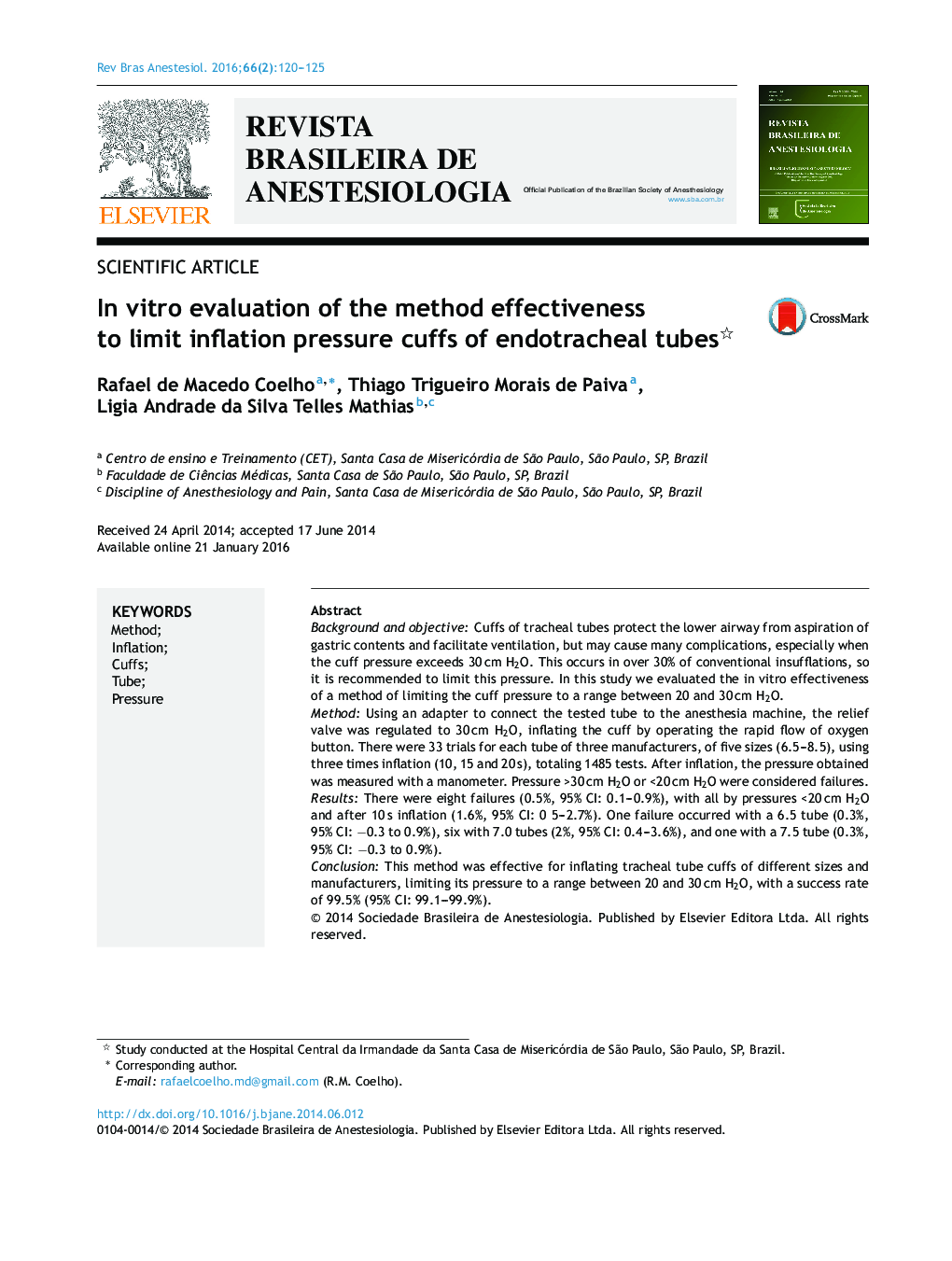| کد مقاله | کد نشریه | سال انتشار | مقاله انگلیسی | نسخه تمام متن |
|---|---|---|---|---|
| 2750139 | 1567299 | 2016 | 6 صفحه PDF | دانلود رایگان |
Background and objectiveCuffs of tracheal tubes protect the lower airway from aspiration of gastric contents and facilitate ventilation, but may cause many complications, especially when the cuff pressure exceeds 30 cm H2O. This occurs in over 30% of conventional insufflations, so it is recommended to limit this pressure. In this study we evaluated the in vitro effectiveness of a method of limiting the cuff pressure to a range between 20 and 30 cm H2O.MethodUsing an adapter to connect the tested tube to the anesthesia machine, the relief valve was regulated to 30 cm H2O, inflating the cuff by operating the rapid flow of oxygen button. There were 33 trials for each tube of three manufacturers, of five sizes (6.5–8.5), using three times inflation (10, 15 and 20 s), totaling 1485 tests. After inflation, the pressure obtained was measured with a manometer. Pressure >30 cm H2O or <20 cm H2O were considered failures.ResultsThere were eight failures (0.5%, 95% CI: 0.1–0.9%), with all by pressures <20 cm H2O and after 10 s inflation (1.6%, 95% CI: 0 5–2.7%). One failure occurred with a 6.5 tube (0.3%, 95% CI: −0.3 to 0.9%), six with 7.0 tubes (2%, 95% CI: 0.4–3.6%), and one with a 7.5 tube (0.3%, 95% CI: −0.3 to 0.9%).ConclusionThis method was effective for inflating tracheal tube cuffs of different sizes and manufacturers, limiting its pressure to a range between 20 and 30 cm H2O, with a success rate of 99.5% (95% CI: 99.1–99.9%).
ResumoJustificativa e objetivoOs balonetes das cânulas traqueais protegem as vias aéreas inferiores da aspiração de conteúdo gástrico e facilitam a ventilação pulmonar, mas podem provocar diversas complicações, principalmente quando a pressão do balonete supera 30 cm H2O. Isto ocorre em mais de 30% das insuflações convencionais, sendo recomendada a limitação desta pressão. Neste estudo avaliou-se in vitro a eficácia de um método para limitar a pressão dos balonetes à faixa entre 20 e 30 cm H2O.MétodoUtilizando um adaptador para conectar a cânula testada ao aparelho de anestesia, regulou-se a válvula limitadora deste a 30 cm H2O, insuflando o balonete por meio do acionamento do botão de fluxo rápido de oxigênio. Realizaram-se 33 testes para cada cânula de três fabricantes, de cinco tamanhos (6.5 a 8.5), utilizando três tempos para insuflação (10, 15 e 20 segundos), totalizando 1485 testes. Terminada a insuflação, mediu-se a pressão obtida com um manômetro. Pressões >30 cm H2O ou <20 cm H2O foram consideradas falhas.ResultadosOcorreram oito falhas (0,5%; IC 95%: 0,1–0,9%), sendo todas por pressões <20 cm H2O e após insuflações de 10 segundos (1,6%; IC 95%: 0,5–2,7%). Uma falha ocorreu com cânula 6.5 (0,3%; IC 95%: −0,3–0,9%), seis com cânulas 7.0 (2%; IC 95%: 0,4–3,6%), e uma com cânula 7.5 (0,3%; IC 95%: −0,3–0,9%).ConclusãoEste método mostrou-se eficaz para insuflar os balonetes de cânulas traqueais de diferentes tamanhos e fabricantes limitando sua pressão à faixa entre 20 e 30 cm H2O, com incidência de sucesso de 99,5% (IC 95%: 99,1–99,9%).
Journal: Brazilian Journal of Anesthesiology (English Edition) - Volume 66, Issue 2, March–April 2016, Pages 120–125
